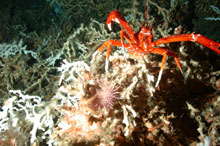
Squat lobsters and sea urchins are just two of the dominant species commonly found in and around deep-water Lophelia bushes. Click image for larger view and image credit.
Life on the Edge 2004
June 8 - 22, 2004
Ft. Pierce, Florida to Cape Lookout, North Carolina
Liz Baird
North Carolina Museum of Natural Sciences
Beyond the beach and influenced by the Gulf Stream, the unique habitats along "the edge" of the continental shelf and the deeper continental slope support myriad life forms. The Life on the Edge 2004 mission, part of a several-year study, aims to document and understand these habitats and the species that live in them. The mission team is searching for coral reefs and other reef habitats, from the sargassum floating in the surface waters to the corals found in deep water. The scientists hope to characterize the trophodynamics (energy flow) and community structures in these environments.
A transition zone exists between the continental shelf and the deep sea. It is rich with commercially valuable fishes as well as unusual species. An abundance of invertebrate fauna, including several species of crustaceans, echinoderms, and sponges, also call this transition zone home.
During the 14-day cruise aboard the Harbor Branch Oceanographic Institution’s research vessel Seward Johnson, the science team will study both the outer-shelf hard grounds, found in relatively shallow water (80 to 200 m), and the middle-slope coral banks, found in deeper water (350 to 800 m).
Most of the habitats in these areas are poorly studied or completely unknown; however, the deep coral (primarily Lophelia pertusa) and shelf-edge reef systems are receiving increasing attention worldwide. They appear to be more extensive and important than previously believed. Little is known about the location of these reefs, how they form, and which species are dependent upon them. At the same time, fishing, energy exploration, and other activities severely threaten their well being.
The Life on the Edge mission supports a collaborative team of scientists, who will be continuing and expanding their work in these deep-water habitats. Team members include Dr. Steve Ross from University of North Carolina at Wilmington; Dr. Ken Sulak of the U.S. Geological Survey; Dr. Martha Nizinski of the National Marine Fisheries Service; and Liz Baird from the North Carolina Museum of Natural Sciences.
The team, along with staff, brings together a vast array of knowledge about deep-water systems. During missions over the past four years, they have documented several range extensions for tropical species, located a shipwreck, collected a specimen of the invasive Indo-Pacific red lionfish, and identified and mapped deep-water coral banks.
This year, they will return to some study sites to gain an understanding of how these areas change over time. They will also search for new and undocumented deep coral banks.
Studying these areas is a “24/7” effort. The bottom topography of the research sites is brutally rugged and/or overlain by extreme currents. These conditions necessitate the mission to use a manned submersible -- the Johnson Sea-Link -- as the primary research tool. The sub provides the most accurate way of measuring fish populations and examining their behaviors.
During the day, scientists will use the Johnson Sea-Link to explore the reef areas, record video transects, and collect targeted specimens. When the submersible is not in the water, and throughout the night, the team will be sampling with traditional gear, including Neuston Nets, plankton nets, and dip nets for the upper water column as well as with trawls for deeper collections. The scientists will also use the ship’s fathometer to record the ocean bottom as they search for new coral banks.
A primary mission goal is to maximize the collection opportunities. For this reason, the collected data will be analyzed back on shore, freeing the at-sea time for actual collection activities. There will be plenty to analyze once the journey is over: one cruise produces enough data to keep the labs busy for several years.
You can follow the progress of the Life on the Edge 2004
mission through the North Carolina Museum of Natural Sciences Web site (www.naturalsciences.org) ![]() . Here you can read daily journals, see photos, examine samples of
data, ask questions, and download curriculum materials. Additional background
information can be found on the Ocean Explorer Web site under the Islands
in the Stream 2001, Islands
in the Stream 2002, and Life on the
Edge 2003 missions.
. Here you can read daily journals, see photos, examine samples of
data, ask questions, and download curriculum materials. Additional background
information can be found on the Ocean Explorer Web site under the Islands
in the Stream 2001, Islands
in the Stream 2002, and Life on the
Edge 2003 missions.

